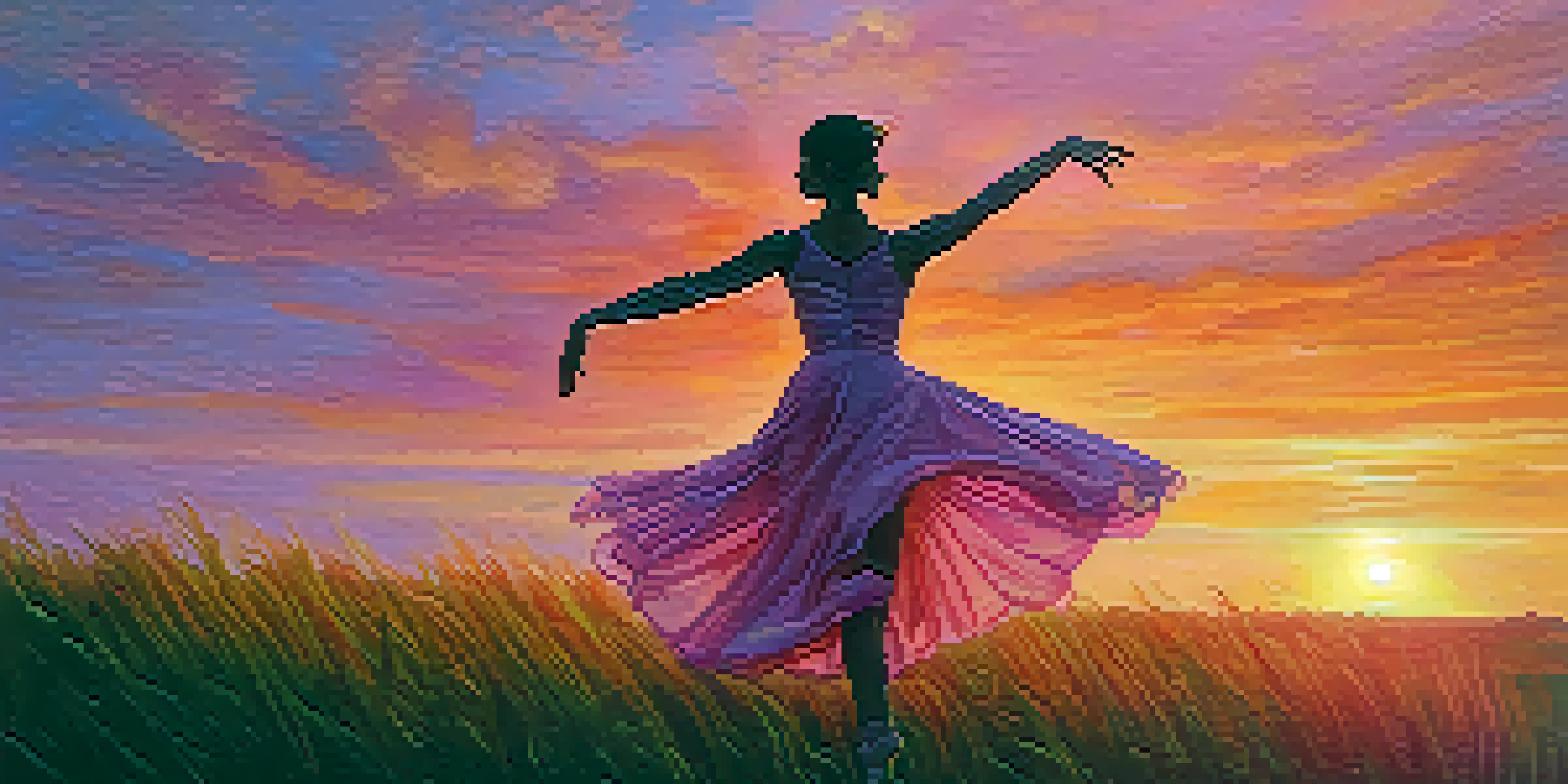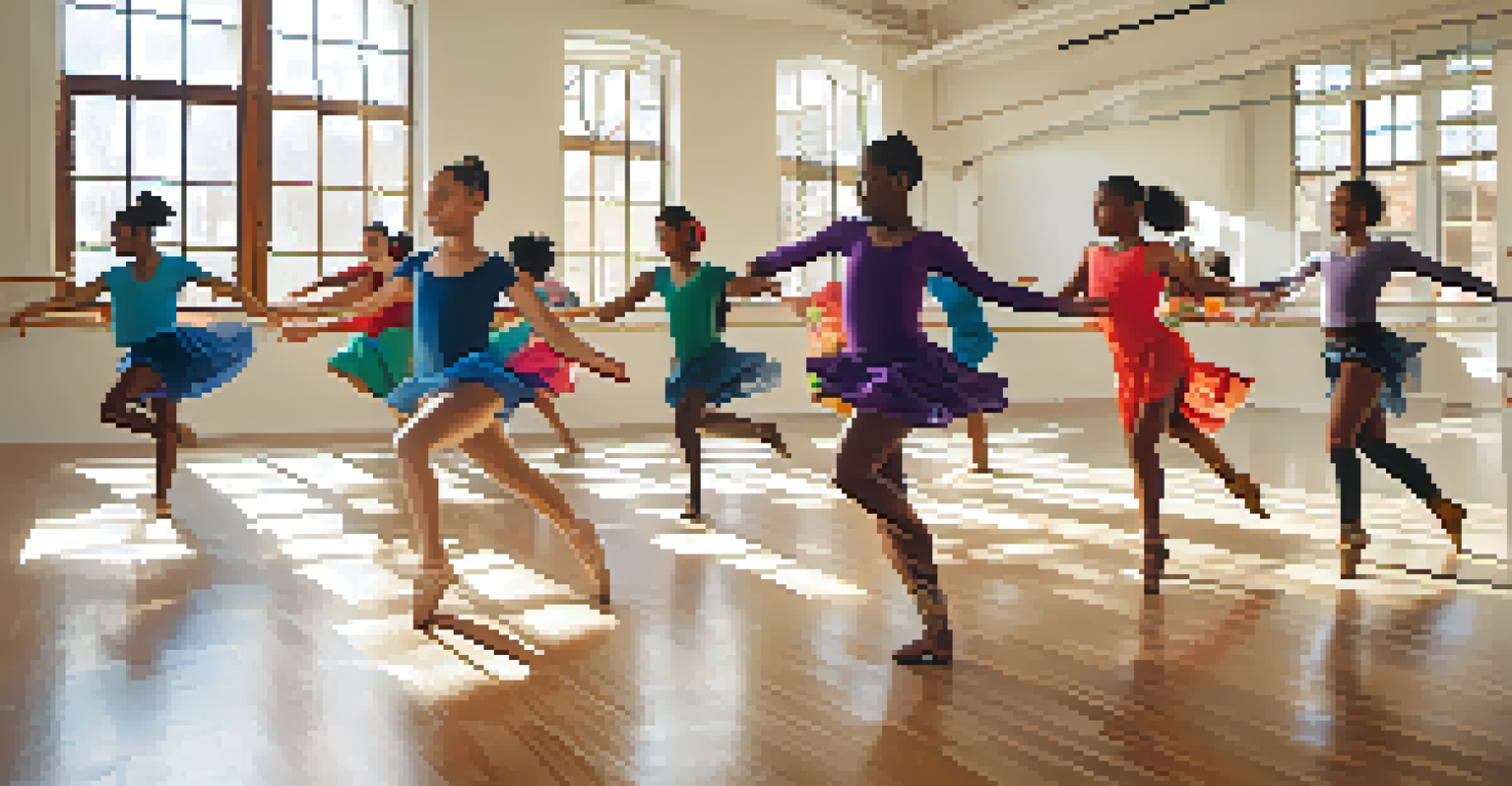Exploring Dance as a Tool for Emotional Expression

Understanding Dance as a Form of Expression
Dance is more than just movement; it's a powerful form of communication. Through dance, individuals can convey emotions that words often fail to express. Whether it’s joy, sadness, frustration, or love, dance allows for a visceral connection to feelings that might otherwise remain hidden.
Dance is the hidden language of the soul.
When we watch someone dance, we often resonate with their emotions, creating a shared experience. This connection can be deeply therapeutic, providing a safe space for individuals to express their innermost feelings. In essence, dance becomes a universal language that transcends barriers, inviting others to join in the emotional journey.
Moreover, the physicality of dance can release pent-up emotions, acting almost like a cathartic experience. Just as a painter uses colors to illustrate their feelings, dancers use movement to paint their emotional landscapes. This dynamic interplay between body and emotion makes dance a unique and compelling vehicle for expression.
The Therapeutic Benefits of Dance
Dance therapy is an established practice that harnesses movement to promote emotional healing. Trained therapists guide individuals through expressive movements, allowing them to explore their feelings in a supportive environment. This approach not only fosters self-awareness but also encourages emotional release.

Many people find that dancing helps alleviate symptoms of anxiety and depression. The act of moving to music can elevate mood and create a sense of joy, much like how a favorite song can lift our spirits. By engaging in dance, individuals may find themselves more in tune with their emotions, leading to a greater understanding of their mental health.
Dance as Emotional Communication
Dance serves as a powerful form of expression, allowing individuals to convey emotions that words often can't.
Additionally, dance fosters social connections, which can be incredibly beneficial for emotional well-being. Whether in a group class or a casual gathering, dancing brings people together, creating a sense of belonging. This community support can be vital in navigating emotional challenges.
Cultural Perspectives on Dance and Emotion
Across cultures, dance has long been a means of expressing emotions and storytelling. From the vibrant movements of traditional African dances to the graceful fluidity of ballet, each style offers a unique glimpse into the emotional landscape of its culture. These dances often celebrate life’s milestones, turning moments of joy, sorrow, and everything in between into art.
Dancing is like dreaming with your feet.
In many cultures, dance is intertwined with rituals and ceremonies, serving as a collective expression of community feelings. For example, Indigenous dances often reflect the community's connection to nature and spirituality, highlighting the deep emotional ties that bind people together. Through these shared experiences, dance becomes a vessel for communal healing and expression.
Moreover, exposure to diverse dance forms can enhance our emotional vocabulary. By witnessing and participating in various dances, we learn to recognize and articulate our emotions more clearly. This cultural exchange fosters empathy and understanding, enriching our emotional experiences.
Dance as a Personal Journey of Self-Discovery
For many, dance serves as a personal journey of self-discovery. Engaging in dance allows individuals to explore their identity and emotions in a safe space. As they move, they often uncover hidden feelings and thoughts, leading to profound insights about themselves.
The process of learning to dance, whether through classes or self-taught methods, can also boost confidence. As dancers master new movements, they gain a sense of accomplishment that translates into other areas of life. This newfound self-assurance can empower individuals to express their emotions more freely, both in dance and in daily interactions.
Therapeutic Benefits of Dance
Engaging in dance therapy promotes emotional healing and fosters self-awareness, helping alleviate symptoms of anxiety and depression.
Ultimately, the act of dancing becomes a form of self-care, encouraging individuals to prioritize their emotional health. It provides an opportunity for reflection, allowing dancers to process their experiences and emotions through movement. This personal connection to dance can be incredibly transformative.
Creating a Dance Practice for Emotional Expression
Establishing a personal dance practice can be a wonderful way to tap into emotional expression. Whether it's through structured classes or spontaneous movement in your living room, the key is to find what feels right for you. Setting aside time to dance allows for a dedicated space to explore your feelings without judgment.
Consider incorporating music that resonates with your emotions. Play songs that evoke specific feelings—whether uplifting or melancholic—and let your body respond. Allow the music to guide you, creating movements that reflect your emotional state. This practice can be incredibly liberating, helping you to connect deeply with your feelings.
It’s also beneficial to keep a dance journal, documenting your experiences and emotions before and after dancing. Reflecting on these sessions can provide valuable insights into your emotional journey. Over time, you’ll likely notice patterns in your feelings and movements, enhancing your understanding of yourself.
The Role of Community in Dance and Emotional Expression
Community plays an essential role in the journey of using dance for emotional expression. Group classes, workshops, or dance circles provide a platform for shared experiences, where individuals can connect through movement. This sense of belonging can amplify the emotional benefits of dance, creating a supportive environment for exploration.
Participating in community dance events can also foster a sense of collective healing. When people dance together, they share both their individual and collective emotions, creating a powerful bond. This shared experience can significantly enhance emotional well-being, reminding us that we are not alone in our feelings.
Community Enhances Dance Experience
Participating in dance within a community fosters connection and collective healing, enriching emotional expression and creativity.
Moreover, community engagement can inspire creativity and open new avenues for emotional expression. Collaborating with others in dance projects or performances allows individuals to explore new styles and interpretations of movement. This creativity can lead to deeper emotional insights and a stronger connection with oneself and others.
Conclusion: Embracing Dance as Emotional Expression
In conclusion, dance serves as a profound tool for emotional expression, enabling individuals to connect with their feelings in powerful ways. Whether through personal practice or community involvement, the act of dancing can unlock emotions that often stay buried. This journey of exploration and expression can lead to greater self-awareness and emotional resilience.
As we embrace dance in our lives, we not only enhance our emotional health but also foster connections with others. By sharing our movements and feelings, we contribute to a collective understanding of the human experience. Dance, in all its forms, invites us to express ourselves authentically.

Ultimately, the beauty of dance lies in its ability to resonate with everyone, regardless of age or background. So, whether you’re a seasoned dancer or a complete novice, consider giving yourself the gift of movement. Dance your feelings, and let the rhythm guide you on a journey of emotional expression.